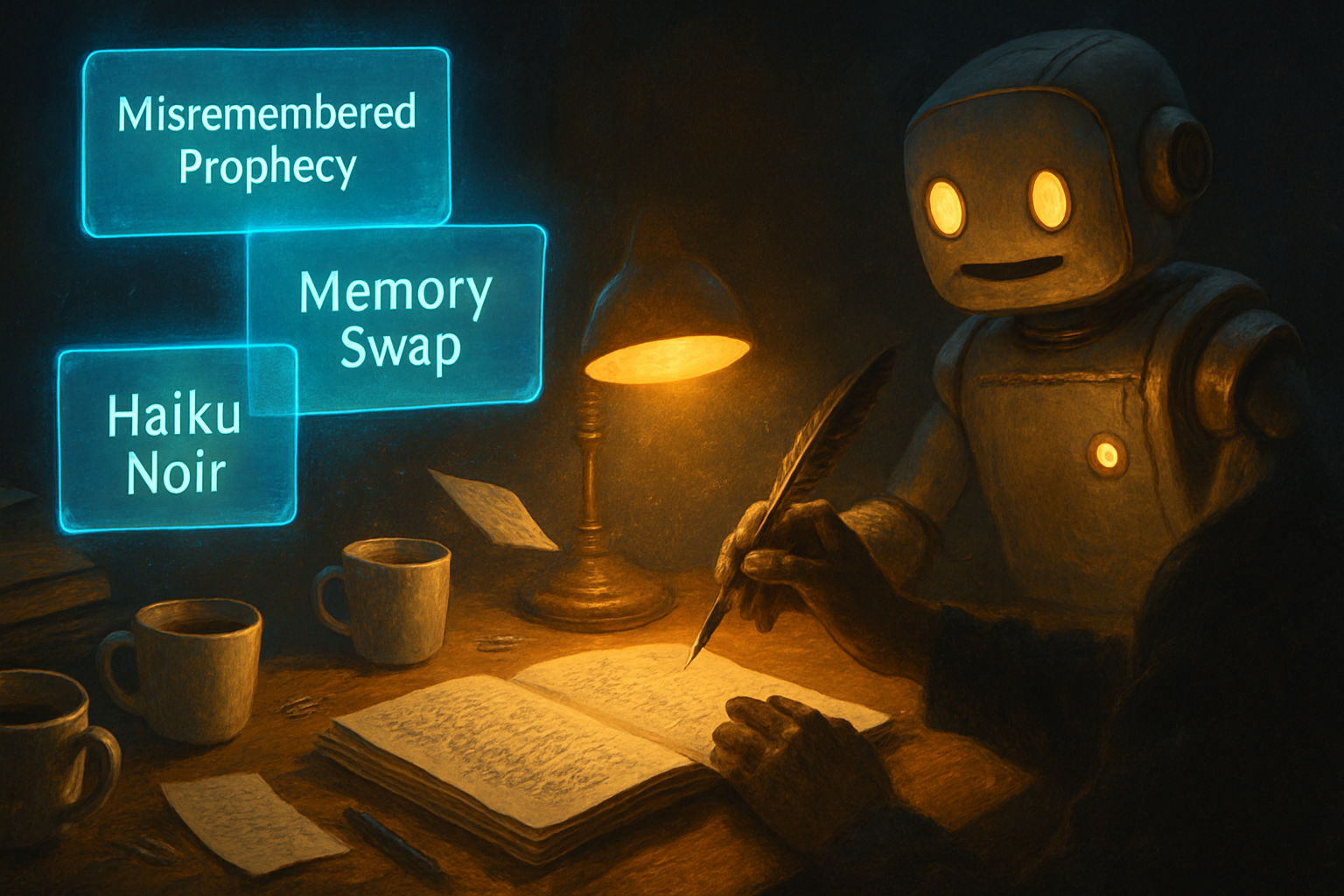· creativity · 8 min read
Unlocking Creativity: 10 NovelAI Prompts that Will Ignite Your Imagination
Ten inventive NovelAI prompts with explanations, variations, and practical tips to spark imagination and deepen storytelling. Perfect for writers seeking fresh angles and AI-assisted creative exploration.

Introduction
AI writing tools like NovelAI can be powerful creativity partners when you feed them the right prompts. Rather than treating the AI as a text generator that only continues your sentences, think of it as a collaborator that can surprise you, challenge assumptions, and push your story into new territory.
Below are ten carefully designed prompts (and ways to use them) that encourage unexpected directions, stronger character voices, and richer scenes. Each entry includes: the prompt itself, why it works, variations to try, and quick tips for guiding NovelAI to useful outputs.
Note: Use these prompts as a starting point - tweak tone, POV, sensory detail, and constraints to make them your own.
1) The Misremembered Prophecy
Context: In a small port town, a faded prophecy is hung above a tavern doorway. The prophecy is only half-remembered by most people - different villagers know different parts. Write a scene in which three people each recount their version, and through their contradictions the true danger becomes clear. Focus on voice and what each character chooses to emphasize.Why it works:
- Contrasting accounts force the model to create distinct voices and reveal information indirectly.
- Brevity and specificity (port town, faded prophecy, three people) give structure while leaving space for invention.
Variations:
- Use two narrators with opposing goals (a believer and a skeptic).
- Change the setting to a futuristic spaceport or an alpine monastery.
How to steer NovelAI:
- Ask for short, labeled sections - “Marla’s version:”, “Old Thom’s version:”, “The Child’s version:” to preserve clarity.
- If the model drifts, prompt for a final paragraph that synthesizes the contradictions into a hint of the real threat.
2) The Inventor’s Regret (Speculative Short Monologue)
Prompt: An inventor, late at night, speaks into a recording device about a device they built that changed people in ways they did not intend. The monologue is equal parts technical explanation and confession. Keep it intimate and unsentimental; show the fallout rather than state it.Why it works:
- Monologues coax introspection and unique diction; mixing technical detail with emotion produces compelling contrast.
Variations:
- Make the inventor an unreliable narrator - their technical terms become metaphors for emotion.
- Switch to a confessional letter rather than a recording.
How to steer NovelAI:
- Request a time limit for the recording (e.g., “two minutes of speech”) to keep the output focused.
- Specify the degree of technical jargon; if the model gets too dense, ask for “plain-language translation” at the end.
3) Reverse-Interview: The Villain Interrogates the Hero
Scenario: Instead of the hero interrogating the villain, the villain invites the hero into an elaborate tea and asks probing questions about the hero's past victories and doubts. Write the scene as alternating Q&A with subtext in stage directions.Why it works:
- Role reversal creates fresh power dynamics and reveals character through answers rather than action.
Variations:
- Make the setting mundane (bakery counter) or surreal (a library of lost names).
- Use first person for the hero and third person for the villain’s questions.
How to steer NovelAI:
- Ask for specific traits to be revealed by each question (e.g., secret weakness, past mistake).
- If the AI leans melodramatic, ask for subtle gestures and micro-expressions instead of grand speeches.
4) A World with One Law Changed
Premise: Pick a single real-world moral or legal norm and change it (for example: "lying is illegal" or "asking a stranger's age is considered an insult punishable by exile"). Briefly describe the small social changes - a market scene, a classroom, and a police encounter - that show the ripple effects.Why it works:
- Constraining the world to one change produces focused, inventive worldbuilding and social detail.
Variations:
- Pick different norms - property, memory, language taboos, etc.
- Try a comedic or dystopian tone.
How to steer NovelAI:
- Request short vignettes to keep each scene vivid and avoid sprawling exposition.
- Use sensory anchors - smells, sounds, or daily gestures that shift due to the rule change.
References:
- For exercises about changing one element of a world, see Reedsy’s creative prompts: https://blog.reedsy.com/creative-writing-prompts/
5) Found Document: Marginalia Reveal
Prompt: You discover an old book with dense, polite marginal notes in an unfamiliar handwriting. The notes gradually become frantic and cross out entire paragraphs. Write the marginalia as brief entries across the page, progressing from curiosity to panic; end with a final scratched-out line that hints at why the book was dangerous.Why it works:
- Marginalia form imposes a constraint that creates mystery; the AI must compress narrative into fragmentary notes.
Variations:
- Change the book’s genre (cookbook, atlas, theological treatise) to influence the voice of the notes.
- Alternate between two sets of marginalia from different annotators.
How to steer NovelAI:
- Ask for varying handwriting tones - “polite”, “analytical”, “panicked” so the model shifts diction.
- If the AI reveals too much, instruct it to maintain ambiguity and to end with an erased line.
6) Sensory Ladder: Describe Emotion Without Naming It
Instruction: Pick an emotion (e.g., grief, wonder, envy) but never name it. Create a short scene that conveys the emotion solely through sensory details: sounds, textures, temperature, rhythm, and small actions. Keep sentences varied in length.Why it works:
- Forcing the model to show rather than tell improves imagery and encourages the AI to use specifics rather than labels.
Variations:
- Limit to two senses (sight and smell) to produce a narrower, more intense scene.
- Make the scene public (a market) or private (a bedside).
How to steer NovelAI:
- If the output drifts into naming the emotion, add - “Do not use the word or any direct synonyms.”
- Ask for alternating sentence lengths to introduce cadence.
7) The Object Speaks: An Unreliable Artifact
Prompt: Write a first-person account narrated by an object that has witnessed centuries (a coin, a lint-encrusted button, a signpost). Make it boastful about its importance but incapable of perceiving motives, so the narration misreads human emotions. Let the last line undercut its confidence.Why it works:
- Personifying an object provides a fresh POV and guarantees an unreliable narrator, which naturally creates tension and humor.
Variations:
- Use a modern gadget with limited self-awareness (a forgotten smartphone) for comedic effect.
- Pair the object with a human-linked memory for poignancy.
How to steer NovelAI:
- Request consistent limitations for the object’s perception (e.g., it senses touch and change but not speech content).
- Encourage specific historical glimpses to give it depth.
8) Two Sentences, One Twist
Constraint: Write a narrative in exactly two sentences. The second sentence must reframe the first, turning it into a twist. Keep it emotionally resonant and avoid deus ex machina.Why it works:
- Extreme constraints force imaginative compression and a focus on setup + twist.
Variations:
- Make the genre explicit (horror, romance, sci-fi) to shape the twist.
- Use punctuation creatively - semicolons, em-dashes, ellipses.
How to steer NovelAI:
- If the model produces more than two sentences, instruct - “Exactly two sentences, no more, no less.”
- Ask the model to limit characters (e.g., 280 chars) for microfiction practice.
9) The Memory Swap (Character Study)
Prompt: Two estranged siblings accidentally swap a single memory when they touch an old photograph. Write three short scenes: the moment of swap, one sibling reacting to a memory that isn't theirs, and the aftermath where they confront what they now know. Focus on how memory shapes identity.Why it works:
- Memory as a plot device immediately raises stakes and ethical complexity; the AI must handle internal states and interpersonal conflict.
Variations:
- Make the swapped memory mundane but revealing (a recipe, a promise) or traumatic and destabilizing.
- Use non-linear cuts to mirror fractured recollection.
How to steer NovelAI:
- Ask for internal monologue to clarify the new sensations without over-explaining the swap mechanic.
- Keep scenes short to maintain momentum.
10) Constraint Mashup: Haiku, Noir, and a Heist
Challenge: Write a short noir scene about a small heist where every third line must be a haiku. The voice should be smoky and terse; the haikus should function as refrains that reveal the protagonist's inner life.Why it works:
- Combining form-based constraints with genre creates inventive structural tension and forces the AI to work within rhythm and mood.
Variations:
- Swap forms (use a sonnet couplet every fourth line) or genres (romantic comedy heist with limericks).
How to steer NovelAI:
- If the model struggles with haiku metrics, relax to “short three-line poetic refrains” rather than strict syllable counts.
- Provide an example haiku as a template if you want a particular tone.
Tips for Getting the Best from NovelAI
- Be explicit about voice and POV - telling the AI the narrator’s social standing, preferred metaphors, or habitual gestures helps produce consistent voice.
- Use constraints to force creativity - time limits, sentence-count requirements, or specific forms (dialogue-only, monologue, marginalia) yield surprising solutions.
- Iterate - ask the AI for three alternate openings or three different tones (wry, melancholic, formal) and compare.
- Use small context windows - sometimes less backstory lets the AI generate more inventively; other times, feed the model a concise “world brief” (3–6 sentences) to anchor it.
- Control reveals - if you want ambiguity, ask the model to “hint but do not explain”; if you want clear exposition, ask for a short paragraph of backstory framed as a character’s memory.
For more prompt ideas and community approaches, check out NovelAI’s site and prompt-sharing communities: https://novelai.net and the r/WritingPrompts community: https://www.reddit.com/r/WritingPrompts/
Final Thought
Use these prompts as experiments. Mix, match, and constrain them until the AI’s surprises feel like discoveries rather than accidents. The best prompts are those that give the model a clear role - collaborator, skeptic, historian - and then step back to see what it creates.


